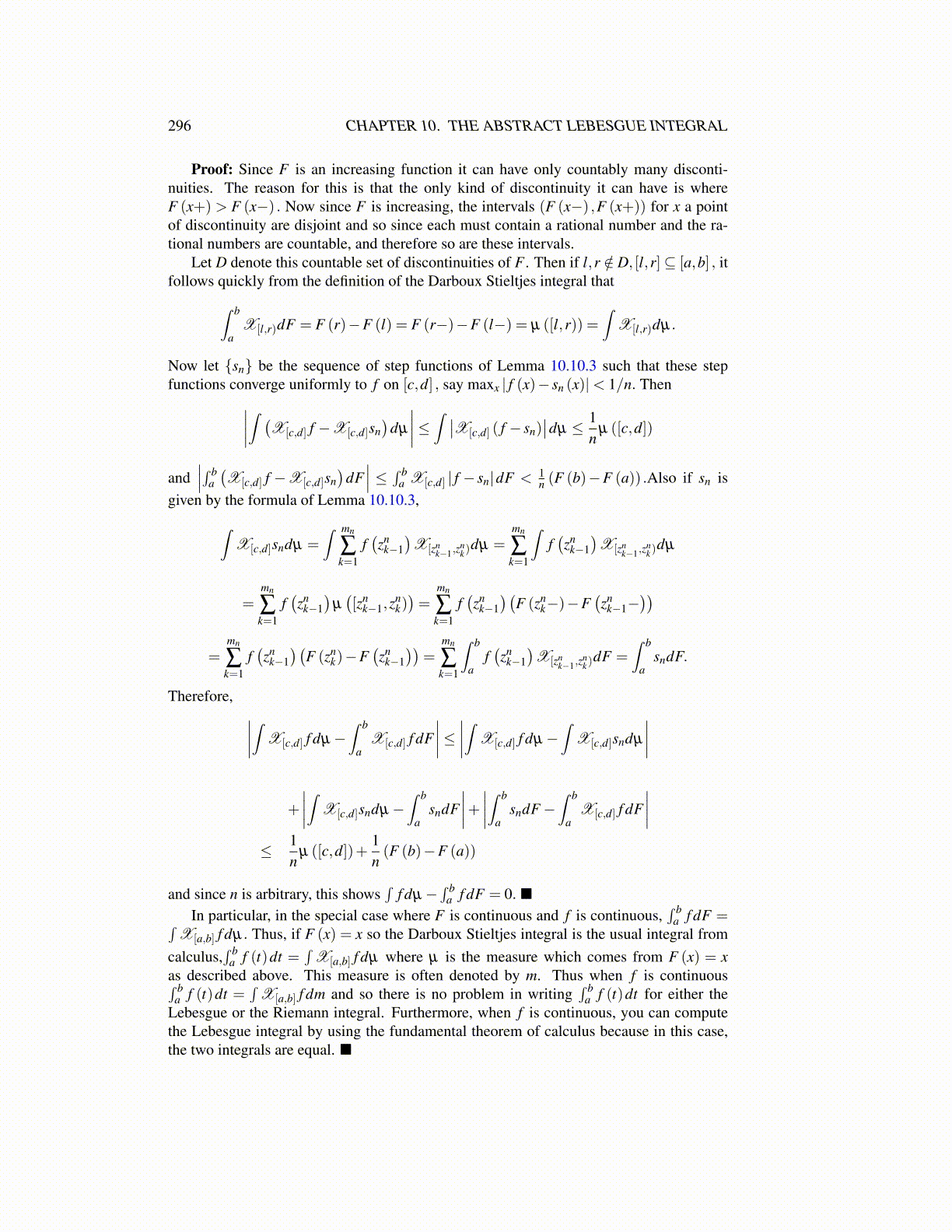
296 CHAPTER 10. THE ABSTRACT LEBESGUE INTEGRAL
Proof: Since F is an increasing function it can have only countably many disconti-nuities. The reason for this is that the only kind of discontinuity it can have is whereF (x+) > F (x−) . Now since F is increasing, the intervals (F (x−) ,F (x+)) for x a pointof discontinuity are disjoint and so since each must contain a rational number and the ra-tional numbers are countable, and therefore so are these intervals.
Let D denote this countable set of discontinuities of F . Then if l,r /∈D, [l,r]⊆ [a,b] , itfollows quickly from the definition of the Darboux Stieltjes integral that∫ b
aX[l,r)dF = F (r)−F (l) = F (r−)−F (l−) = µ ([l,r)) =
∫X[l,r)dµ.
Now let {sn} be the sequence of step functions of Lemma 10.10.3 such that these stepfunctions converge uniformly to f on [c,d] , say maxx | f (x)− sn (x)|< 1/n. Then∣∣∣∣∫ (X[c,d] f −X[c,d]sn
)dµ
∣∣∣∣≤ ∫ ∣∣X[c,d] ( f − sn)∣∣dµ ≤ 1
nµ ([c,d])
and∣∣∣∫ b
a(X[c,d] f −X[c,d]sn
)dF∣∣∣ ≤ ∫ b
a X[c,d] | f − sn|dF < 1n (F (b)−F (a)) .Also if sn is
given by the formula of Lemma 10.10.3,∫X[c,d]sndµ =
∫ mn
∑k=1
f(zn
k−1)X[zn
k−1,znk)
dµ =mn
∑k=1
∫f(zn
k−1)X[zn
k−1,znk)
dµ
=mn
∑k=1
f(zn
k−1)
µ([zn
k−1,znk))=
mn
∑k=1
f(zn
k−1)(
F (znk−)−F
(zn
k−1−))
=mn
∑k=1
f(zn
k−1)(
F (znk)−F
(zn
k−1))
=mn
∑k=1
∫ b
af(zn
k−1)X[zn
k−1,znk)
dF =∫ b
asndF.
Therefore, ∣∣∣∣∫ X[c,d] f dµ−∫ b
aX[c,d] f dF
∣∣∣∣≤ ∣∣∣∣∫ X[c,d] f dµ−∫
X[c,d]sndµ
∣∣∣∣+
∣∣∣∣∫ X[c,d]sndµ−∫ b
asndF
∣∣∣∣+ ∣∣∣∣∫ b
asndF−
∫ b
aX[c,d] f dF
∣∣∣∣≤ 1
nµ ([c,d])+
1n(F (b)−F (a))
and since n is arbitrary, this shows∫
f dµ−∫ b
a f dF = 0. ■In particular, in the special case where F is continuous and f is continuous,
∫ ba f dF =∫
X[a,b] f dµ. Thus, if F (x) = x so the Darboux Stieltjes integral is the usual integral fromcalculus,
∫ ba f (t)dt =
∫X[a,b] f dµ where µ is the measure which comes from F (x) = x
as described above. This measure is often denoted by m. Thus when f is continuous∫ ba f (t)dt =
∫X[a,b] f dm and so there is no problem in writing
∫ ba f (t)dt for either the
Lebesgue or the Riemann integral. Furthermore, when f is continuous, you can computethe Lebesgue integral by using the fundamental theorem of calculus because in this case,the two integrals are equal. ■